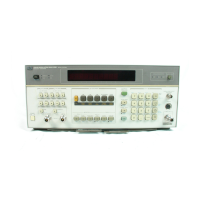General Information Model 8901B
I
r
(a)
BASEBAND SIGNAL
When the baseband
signal
is
symmetrical, the modulation index can
also
be expressed
in
terms of the
average carrier level,
A,
and the envelope peak,
T,
relative
to
the carrier. Then
P
=
A+r,
and
T
=
A-
r,
and the expression for modulation index becomes
27
r
x
100%
=
-
x
100%
=
-
x
100%.
2A
A
A+r-A+r
m=
A+r+A-r
This
is
the expression which the Modulation Analyzer evaluates when making an AM measurement,
Referring back
to
Figure 1-3, it
is
apparent that
A
=
1
and
T
=
0.5
so,
as
before
m
=
-
0.5
x
100%
=
50%
1
The Modulation Analyzer makes an AM measurement
by
forcing the average carrier level,
A,
to
a
known, fixed level by means of
an
automatic level control (ALC) circuit. The signal
is
then demodulated,
and the amplitude of the recovered baseband
signal
is
measured with a peak detector. The output of
the detector
is
r,
which
is
(in
effect) multiplied by the constant
1OO/A
and displayed
as
the
9%
AM.
(b)
AMPLITUDE MODULATED CARRIER
I
Figure
1-5.
AM with an Asymmetrical Baseband Signal
The range
of
modulation indexes
for
AM measurements by the Modulation Analyzer
is
essentially
0
to
100%.
There are, however, types of modulation that produce modulation indexes greater than 100%.
An example of such is suppressed-carrier AM. The Modulation Analyzer
is
not intended for measuring
such signals. Nevertheless, there are cases, when the Modulation Analyzer will display a modulation
index that exceeds
100%.
This can occur,
for
example, on an asymmetrical waveform where a narrow
peak
is
greater than the average carrier level. This is illustrated in Figure 1-6.
1-14

